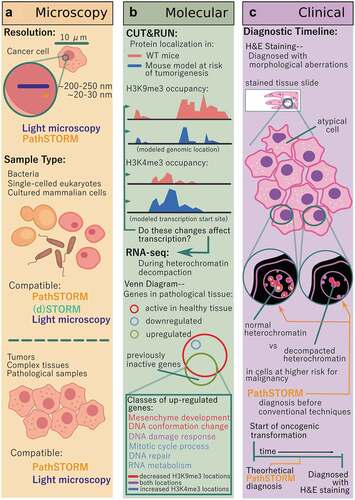Figures & data
Figure 1. Advances enabled by PathSTORM in the fields of microscopy, clinical diagnosis, and academic research. (a) Other STORM methods have broken the diffraction barrier limiting conventional light microscopy to a resolution of ~250 nm, and PathSTORM compares to other optimized STORM protocols, resulting in a resolution of ~30 nm. While other STORM technologies are only able to image thin, homogenous samples, PathSTORM and light microscopy can image both these and complex, pathological tissue samples. (b) CUT&RUN enables the acquisition of high-quality, low-background protein localization on chromatin, and found decreased H3K9me3 occupancy and increased H3K4me3. RNA-seq data confirmed that these architectural changes influenced transcription at differentially organized locations, and Gene Ontology (GO)-term analysis identified that the most significantly enriched pathways were mesenchymal development (a process leading to acquisition of invasiveness and malignancy in epithelial cancer cells), cellular response to DNA damage stimulus, and mitotic cell cycle process critical for maintaining genomic stability. (c) PathSTORM improves upon conventional cancer diagnostic methods (such as H&E staining) by enabling the potential to characterize the genomic architecture preceding the onset of tumorigenesis, where conventional methods rely on visualizing the morphological changes of the cell and cell nucleus after the onset of dysregulation.

